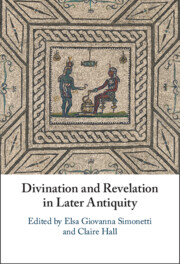Book contents
- Divination and Revelation in Later Antiquity
- Divination and Revelation in Later Antiquity
- Copyright page
- Contents
- Illustrations
- Notes on Contributors
- Acknowledgements
- Introduction
- Part I Philosophical Perspectives on Divination, Revelation, and Prophecy
- Part II Status, Role, and Functions of Human Intermediaries
- Chapter 5 ‘The Holiest Man Ever Born’: Sages, Theioi Andres, and the Shaping of Late Greek Prophecy
- Chapter 6 Women and Divine Dreams in Jewish Texts of the Greco-Roman Era
- Chapter 7 Epiphany and Divination Reconsidered
- Chapter 8 The True Prophet in the Pseudo-Clementine Homilies
- Part III Divine Transcendence and Pragmatic Purposes
- Index
- References
Chapter 8 - The True Prophet in the Pseudo-Clementine Homilies
from Part II - Status, Role, and Functions of Human Intermediaries
Published online by Cambridge University Press: 19 October 2023
- Divination and Revelation in Later Antiquity
- Divination and Revelation in Later Antiquity
- Copyright page
- Contents
- Illustrations
- Notes on Contributors
- Acknowledgements
- Introduction
- Part I Philosophical Perspectives on Divination, Revelation, and Prophecy
- Part II Status, Role, and Functions of Human Intermediaries
- Chapter 5 ‘The Holiest Man Ever Born’: Sages, Theioi Andres, and the Shaping of Late Greek Prophecy
- Chapter 6 Women and Divine Dreams in Jewish Texts of the Greco-Roman Era
- Chapter 7 Epiphany and Divination Reconsidered
- Chapter 8 The True Prophet in the Pseudo-Clementine Homilies
- Part III Divine Transcendence and Pragmatic Purposes
- Index
- References
Summary
Philosophy, magic and Scripture are not capable of leading men to the knowledge of truth. According to Pseudo-Clement, truth is revealed only by the True Prophet, because he alone possesses full knowledge of it. Anyone can recognise the True Prophet, provided that they are animated by a genuine desire to know the truth and that they meet a genuine witness. The witness does not prove the truth of the doctrine that he teaches, but he puts the hearers in the presence of the One from whom he has himself received the truth. Truth – though rationally arguable – is not conceptual knowledge, but evidence derived from the encounter, mediated by authentic witnesses, between the seeker and the Prophet.
Keywords
- Type
- Chapter
- Information
- Divination and Revelation in Later Antiquity , pp. 159 - 176Publisher: Cambridge University PressPrint publication year: 2023

